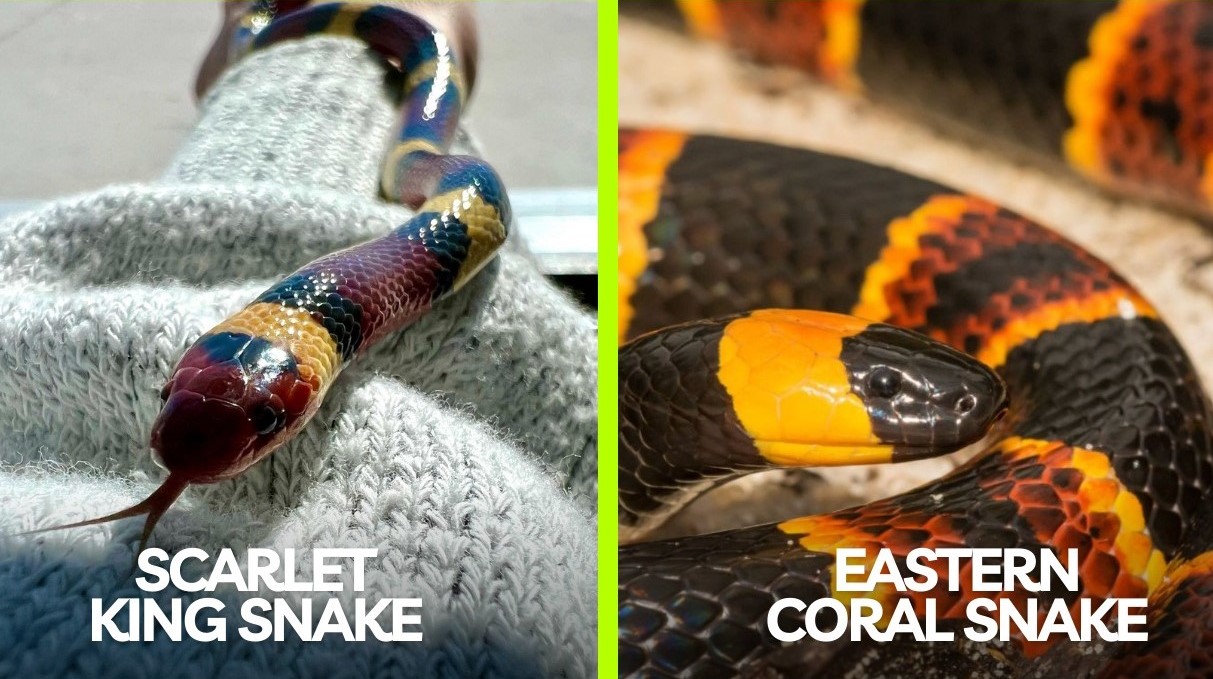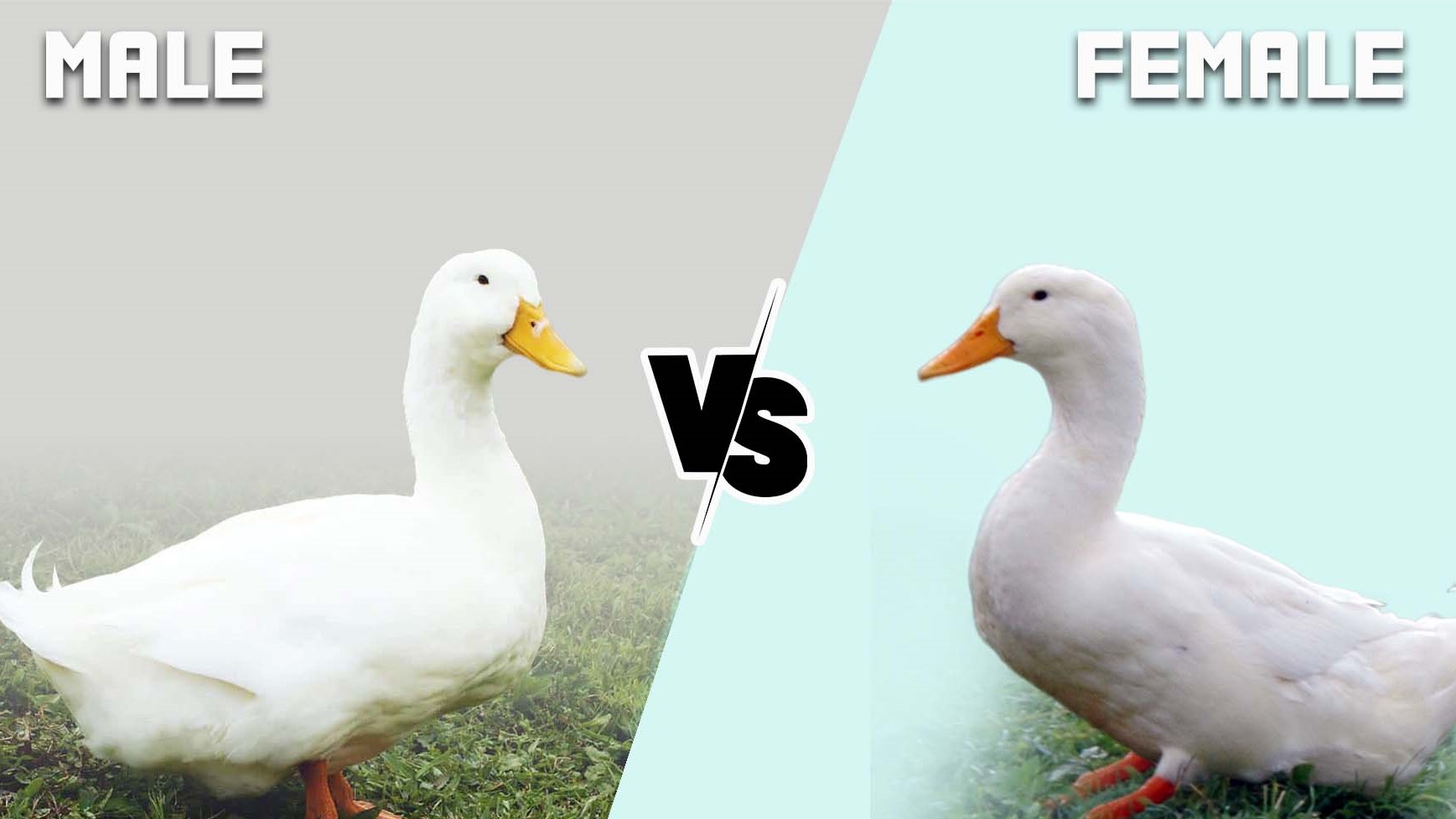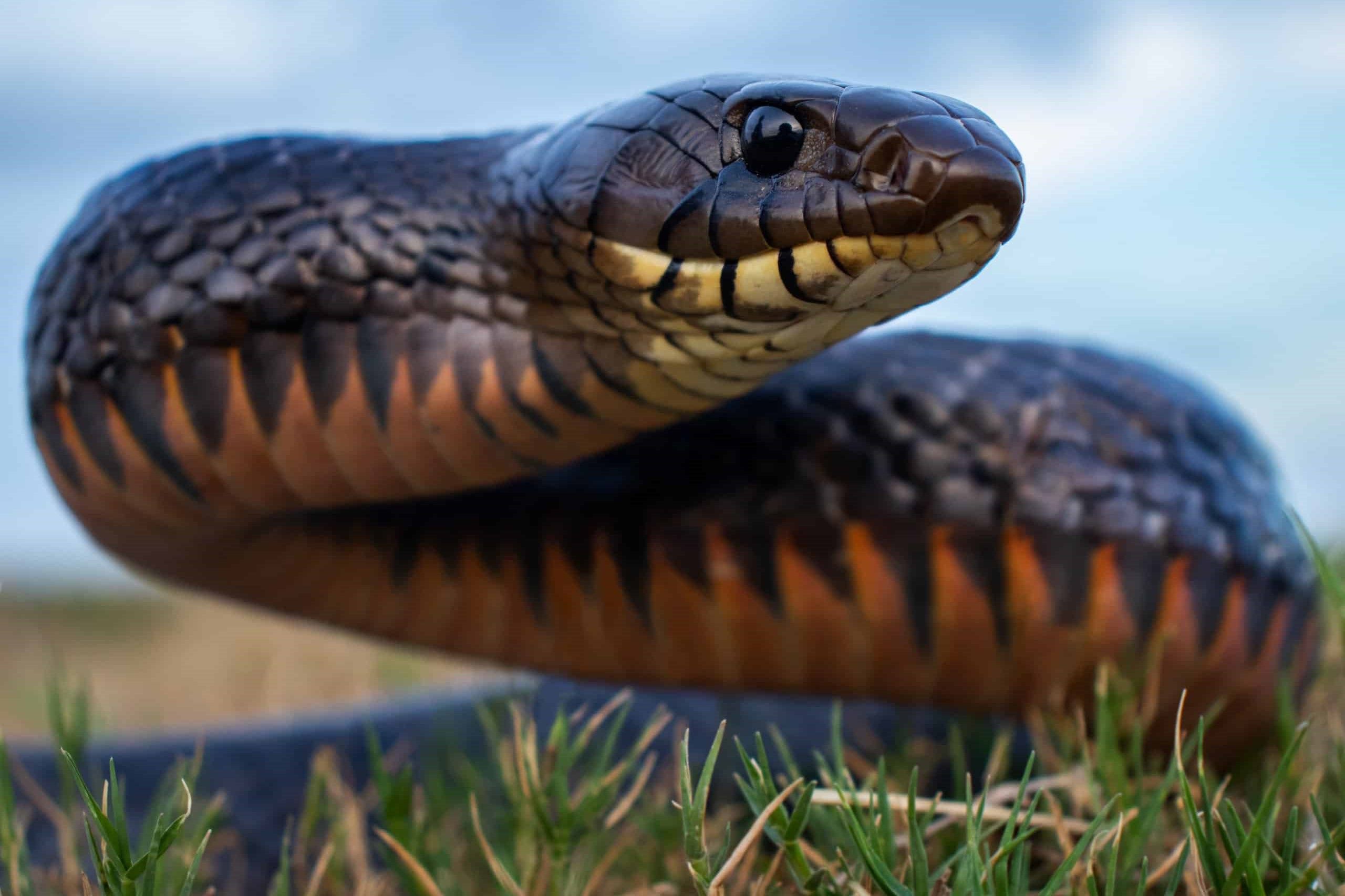Home>Pets & Animals>The Ultimate Guide To Distinguishing Coral Snakes From King Snakes


Pets & Animals
The Ultimate Guide To Distinguishing Coral Snakes From King Snakes
Published: February 11, 2024
Learn how to distinguish coral snakes from king snakes with our ultimate guide. Essential information for pet owners and animal enthusiasts.
(Many of the links in this article redirect to a specific reviewed product. Your purchase of these products through affiliate links helps to generate commission for Noodls.com, at no extra cost. Learn more)
Table of Contents
Introduction
Coral snakes and king snakes are two fascinating reptiles that share similar appearances, often leading to confusion among enthusiasts and casual observers. Both species boast vibrant and visually striking patterns, making them captivating subjects for study and admiration. However, despite their aesthetic similarities, these snakes possess distinct characteristics that set them apart. Understanding these differences is crucial for anyone interested in these creatures, particularly for those residing in regions where both species coexist.
In this comprehensive guide, we will delve into the intricate details that distinguish coral snakes from king snakes. By exploring their physical characteristics, geographic distribution, behavioral differences, and the crucial distinction between venomous and non-venomous species, readers will gain a deeper understanding of these remarkable reptiles. Whether you're an avid herpetologist, a nature enthusiast, or simply someone seeking to expand their knowledge of the natural world, this guide will provide valuable insights into these captivating serpents.
So, let's embark on a captivating journey into the world of coral snakes and king snakes, unraveling the mysteries that make these creatures both alluring and distinct. Through this exploration, you will gain a newfound appreciation for the intricate beauty and unique traits of these remarkable reptiles.
Physical Characteristics of Coral Snakes
Coral snakes, members of the Elapidae family, are renowned for their visually striking appearance. These slender serpents typically exhibit a distinctive color pattern characterized by vibrant bands of red, yellow, and black encircling their bodies. The classic rhyme "red on yellow, kill a fellow; red on black, friend of Jack" serves as a helpful mnemonic device for distinguishing the venomous coral snake from non-venomous mimics such as the scarlet king snake. This coloration, known as aposematic coloration, serves as a warning to potential predators, signaling the snake's potent venom and deterring them from approaching.
In addition to their vivid coloration, coral snakes possess smooth, glossy scales that contribute to their sleek and elegant appearance. Their relatively small size, typically ranging from 20 to 30 inches in length, further distinguishes them from larger snake species. Their slender bodies and diminutive size allow them to navigate through narrow spaces with ease, making them adept at maneuvering through their natural habitats.
Furthermore, coral snakes are equipped with a pair of small, fixed fangs located at the front of their upper jaw. These fangs are used to inject potent neurotoxic venom into their prey, which primarily consists of small reptiles, amphibians, and occasionally other snakes. The neurotoxins in their venom target the nervous system, leading to paralysis and, in severe cases, respiratory failure. This potent venom underscores the importance of exercising caution and respect when encountering these captivating yet potentially dangerous creatures.
In terms of behavior, coral snakes are generally reclusive and elusive, preferring to avoid confrontation with larger animals. Their secretive nature, coupled with their cryptic coloration, allows them to blend seamlessly into their natural surroundings, making them challenging to spot in the wild. Despite their venomous capabilities, coral snakes are not aggressive and will typically only bite when provoked or mishandled.
Overall, the physical characteristics of coral snakes, from their vibrant coloration to their sleek bodies and potent venom, contribute to their enigmatic allure. Understanding these distinctive traits is essential for appreciating the unique role that coral snakes play in their ecosystems and for ensuring the safety of both humans and these captivating reptiles.
Physical Characteristics of King Snakes
King snakes, belonging to the Lampropeltis genus, are renowned for their captivating appearance and remarkable physical attributes. These non-venomous serpents exhibit a diverse range of color patterns, with some of the most common variations including banded, speckled, and striped designs. Their striking coloration often features a combination of black, white, and brown, creating visually stunning patterns that vary across different subspecies and geographic regions.
One of the most distinctive features of king snakes is their robust and muscular build, which sets them apart from the slender and elongated bodies of many other snake species. This physical attribute, coupled with their relatively moderate length ranging from 3 to 6 feet, contributes to their impressive strength and agility. These qualities enable king snakes to navigate diverse terrains and exhibit remarkable prowess in capturing their prey, which primarily consists of small mammals, birds, reptiles, and amphibians.
In addition to their muscular build, king snakes are characterized by smooth and glossy scales that lend a sleek and polished appearance to their bodies. These scales, which provide protection and aid in locomotion, contribute to the overall resilience and adaptability of these remarkable reptiles. Furthermore, their distinctive head shape, marked by prominent eyes and a slightly flattened appearance, enhances their visual acuity and contributes to their adeptness as predators.
Behaviorally, king snakes are known for their voracious appetite and impressive hunting skills. They are opportunistic feeders, capable of consuming a wide range of prey, including rodents, lizards, and even other snakes, earning them the moniker "king" due to their ability to prey on venomous serpents. This dietary versatility, coupled with their powerful constriction abilities, positions king snakes as apex predators within their respective ecosystems.
Moreover, king snakes are renowned for their docile temperament, making them popular choices among reptile enthusiasts and hobbyists. Their calm and non-aggressive nature, coupled with their visually captivating appearance, has contributed to their widespread popularity in the pet trade. However, it is essential to recognize that while king snakes are non-venomous and generally tolerant of human interaction, they should be handled with care and respect to ensure their well-being and minimize stress.
In summary, the physical characteristics of king snakes, from their robust build and striking coloration to their impressive hunting abilities and docile temperament, underscore the unique charm and ecological significance of these captivating reptiles. Understanding and appreciating these distinctive traits is essential for fostering a deeper admiration for the natural world and the diverse array of species that inhabit it.
Geographic Distribution
Coral snakes and king snakes exhibit distinct geographic distributions, with each species occupying specific regions and habitats across North and Central America. Understanding the range and distribution of these snakes is crucial for wildlife enthusiasts, researchers, and individuals residing in areas where these species coexist.
Coral snakes are primarily found in the southern United States, particularly in states such as Florida, Texas, Arizona, and parts of Louisiana. Their range extends into Central America, encompassing regions of Mexico and as far south as Costa Rica. These snakes thrive in diverse habitats, including wooded areas, marshes, and coastal plains. Their preference for concealed and humid environments, such as leaf litter, sandy soils, and dense vegetation, contributes to their elusive nature and makes them challenging to encounter in the wild.
In contrast, king snakes have a broader distribution, encompassing a wide range of habitats across North and Central America. They are found in various ecosystems, including forests, grasslands, deserts, and even urban areas. In the United States, king snakes are distributed across a vast expanse, ranging from the southeastern states to the southwestern regions, with certain species extending into California and parts of the Midwest. Additionally, their range extends into Mexico and Central America, where they inhabit diverse landscapes and exhibit remarkable adaptability to different environmental conditions.
The geographic distribution of these snakes is influenced by factors such as climate, prey availability, and habitat suitability. Coral snakes, with their preference for concealed and humid environments, are often associated with regions characterized by dense vegetation and moderate temperatures. In contrast, king snakes display a remarkable ability to thrive in a wide range of habitats, from arid deserts to lush woodlands, reflecting their adaptability and resilience across diverse landscapes.
Understanding the geographic distribution of coral snakes and king snakes is essential for conservation efforts, as it provides valuable insights into the ecological roles and population dynamics of these species. Furthermore, this knowledge enables researchers and wildlife enthusiasts to appreciate the intricate relationship between these snakes and their respective habitats, fostering a deeper understanding of the complex and interconnected ecosystems they inhabit.
In summary, the geographic distribution of coral snakes and king snakes reflects the diverse array of habitats they occupy, underscoring the remarkable adaptability and ecological significance of these captivating reptiles. Their presence across distinct regions serves as a testament to the intricate interplay between these snakes and the natural environments they call home.
Behavioral Differences
Coral snakes and king snakes exhibit notable behavioral differences that contribute to their distinct ecological roles and interactions within their respective habitats. Understanding these behavioral disparities is essential for gaining a comprehensive insight into the unique behavioral patterns and ecological significance of these captivating reptiles.
Coral snakes, characterized by their secretive and reclusive nature, are known for their elusive behavior. These serpents prefer to avoid confrontation and are adept at concealing themselves within their natural surroundings. Their cryptic coloration, featuring vibrant bands of red, yellow, and black, serves as a form of camouflage, allowing them to blend seamlessly into their habitat. This secretive behavior aligns with their preference for concealed environments, such as leaf litter, sandy soils, and dense vegetation. Coral snakes are primarily active during the warmer months, and their elusive nature makes them challenging to encounter in the wild. Furthermore, these snakes are not aggressive and will typically only bite when provoked or mishandled, emphasizing their inclination towards avoidance rather than confrontation.
In contrast, king snakes exhibit a more active and exploratory behavioral repertoire. These serpents are renowned for their voracious appetite and impressive hunting skills, displaying a proactive approach to foraging and capturing prey. Their adaptability to diverse habitats, ranging from forests to deserts, reflects their exploratory nature and ability to thrive across varied landscapes. Additionally, king snakes are known for their docile temperament, making them more tolerant of human interaction compared to coral snakes. This behavioral trait has contributed to their popularity in the pet trade, as they are often regarded as suitable reptile companions due to their calm demeanor and adaptability to captive environments.
Furthermore, king snakes are recognized for their dietary versatility, capable of consuming a wide range of prey, including rodents, lizards, and even other snakes. This opportunistic feeding behavior positions them as apex predators within their ecosystems, playing a crucial role in regulating prey populations and contributing to the ecological balance of their habitats. Their proactive hunting behavior, coupled with their ability to consume venomous snakes, underscores their significance as natural regulators within their respective food webs.
In summary, the behavioral differences between coral snakes and king snakes encompass their activity patterns, foraging behaviors, and interactions with their environments. These distinctive behavioral traits underscore the diverse ecological roles and contributions of these captivating reptiles within their respective ecosystems, highlighting the intricate and dynamic nature of the natural world.
Venomous vs. Non-venomous
Distinguishing between venomous and non-venomous snakes is a crucial aspect of herpetology and wildlife awareness. In the context of coral snakes and king snakes, this differentiation holds significant implications for human safety, ecological dynamics, and conservation efforts. Understanding the distinct venomous and non-venomous attributes of these serpents is essential for fostering a comprehensive appreciation of their roles within their respective ecosystems.
Coral snakes, renowned for their vibrant coloration and potent venom, are classified as venomous snakes. Their neurotoxic venom, delivered through small, fixed fangs, targets the nervous system of their prey, leading to paralysis and, in severe cases, respiratory failure. The potent nature of their venom underscores the importance of exercising caution and respect when encountering these captivating yet potentially dangerous creatures. The classic rhyme "red on yellow, kill a fellow; red on black, friend of Jack" serves as a helpful mnemonic device for distinguishing the venomous coral snake from non-venomous mimics such as the scarlet king snake. This mnemonic emphasizes the critical role of accurate identification in mitigating potential risks associated with venomous snake encounters.
In contrast, king snakes are classified as non-venomous, possessing no venomous glands or specialized fangs for venom delivery. Instead, they rely on powerful constriction to subdue their prey, showcasing remarkable hunting skills and adaptability. Despite their non-venomous nature, king snakes are formidable predators, capable of consuming a diverse array of prey, including rodents, lizards, and even other snakes. Their dietary versatility and adeptness as hunters position them as apex predators within their ecosystems, contributing to the regulation of prey populations and the ecological balance of their habitats.
The distinction between venomous coral snakes and non-venomous king snakes underscores the intricate interplay between predator-prey dynamics, ecological interactions, and human-wildlife coexistence. This differentiation serves as a foundation for informed decision-making in wildlife encounters, emphasizing the importance of accurate species identification and respectful cohabitation with these captivating reptiles.
In summary, the distinction between venomous and non-venomous snakes, exemplified by coral snakes and king snakes, highlights the diverse ecological roles and behavioral adaptations of these remarkable reptiles. This distinction serves as a cornerstone for fostering a deeper understanding of the complex and interconnected web of life within natural ecosystems, underscoring the significance of accurate species identification and informed wildlife stewardship.
Conclusion
In conclusion, the captivating world of coral snakes and king snakes unveils a tapestry of remarkable traits, behaviors, and ecological significance. Through our exploration of their physical characteristics, geographic distribution, behavioral disparities, and the crucial distinction between venomous and non-venomous attributes, we have gained valuable insights into the intricate nature of these captivating reptiles.
The physical characteristics of coral snakes, characterized by their vibrant coloration, sleek bodies, and potent venom, underscore their enigmatic allure and the pivotal role they play within their ecosystems. Their elusive behavior and cryptic coloration reflect a delicate balance between concealment and warning, highlighting their adaptation to concealed environments and their reliance on aposematic signals to deter potential predators.
Conversely, the physical attributes of king snakes, including their robust build, striking color patterns, and impressive hunting abilities, showcase their adaptability and resilience across diverse habitats. Their exploratory nature, dietary versatility, and docile temperament position them as formidable predators and popular choices among reptile enthusiasts, underscoring their ecological significance and widespread appeal.
Furthermore, the geographic distribution of these snakes provides valuable insights into the diverse landscapes they inhabit and the intricate interplay between these serpents and their respective habitats. Coral snakes, with their preference for concealed and humid environments, and king snakes, known for their adaptability to varied terrains, exemplify the diverse ecological niches these species occupy, reflecting the complex dynamics of their natural environments.
The behavioral disparities between coral snakes and king snakes, encompassing their activity patterns, foraging behaviors, and interactions with their environments, highlight the diverse ecological roles and contributions of these captivating reptiles within their respective ecosystems. These behavioral traits underscore the intricate and dynamic nature of the natural world, emphasizing the interconnectedness of species and the complex web of life within their habitats.
Lastly, the crucial distinction between venomous coral snakes and non-venomous king snakes serves as a cornerstone for informed decision-making in wildlife encounters, emphasizing the importance of accurate species identification and respectful cohabitation with these captivating reptiles. This differentiation underscores the diverse ecological roles and behavioral adaptations of these remarkable reptiles, fostering a deeper understanding of the complex and interconnected web of life within natural ecosystems.
In essence, the exploration of coral snakes and king snakes unveils a rich tapestry of ecological intricacies, behavioral adaptations, and captivating traits that contribute to the vibrant mosaic of the natural world. By delving into the nuances of these remarkable reptiles, we gain a deeper appreciation for the diverse array of species that inhabit our planet, fostering a sense of wonder and reverence for the intricate beauty and ecological significance of these captivating serpents.














